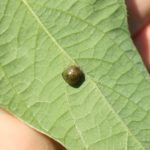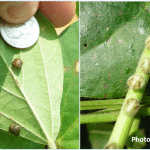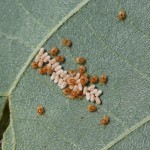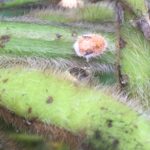I’ve been watching kudzu bug populations on kudzu, and I am now seeing late-instar immature stages and next-generation adults. This means we will start seeing adults migrating into some soybean fields. With the mild winter and early spring, this migration will be sooner than we’ve seen in the past. We might have expected it to be larger also, but populations on kudzu do not seem especially high. A fungus (Beauveria bassiana) has helped considerably at reducing populations of kudzu bug , and I’m hoping we again see the benefits this year. You will notice a fuzzy white fungus growing on dead nymphs and adults when they are filled by Beauveria.
I want to remind everyone NOT to be over aggressive with insecticide applications. Like making a diamond, it takes time and pressure before kudzu bugs cause yield loss. Don’t spray the adults as they migrate into fields. If you jump the gun, and second spray may be necessary. Wait until you begin picking up nymphs in your sweep net, and use a treatment threshold of 1 nymph per sweep. This may take several weeks after the first adults are observed in fields. My data from last year showed this threshold worked well at preserving yield. Bifenthrin products like Brigade, cyhalothrin products such as Warrior, and other pyrethroid insecticides such as Mustang Max and Declare provide good control; however, Baythroid XL and Tombstone are not as good.
I’ve included a few pictures below to remind folks what these critters look like. Be especially alert in areas where kudzu is most common, but kudzu bugs are good fliers so patches don’t have to be especially close to soybean fields to cause a problem.





